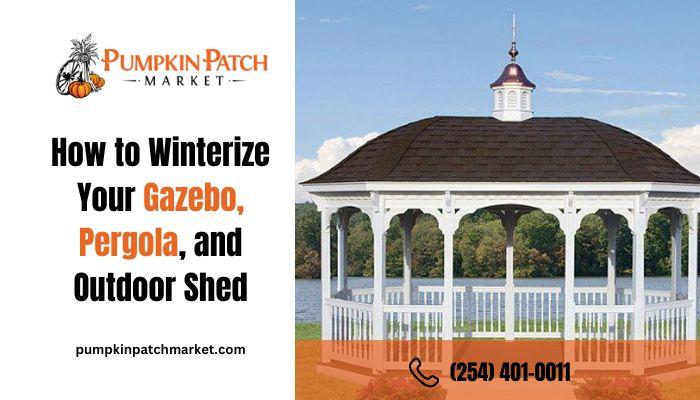There’s something special about the way winter settles in across Vermont, the crisp air, snow-dusted trees, and the quiet stillness that turns our backyards into peaceful retreats. But while the beauty of the season is undeniable, it also brings a few practical challenges, especially for those of us who cherish our outdoor spaces year-round.
If you’ve got a gazebo where summer evenings were spent sipping lemonade, a pergola that held up string lights and grapevines, or a shed that keeps your tools and treasures safe, winter is the time to give them a little extra care. These structures, especially when built with real wood or open designs, face months of snow, wind, and moisture that can slowly wear them down if left unprotected.
Taking a bit of time now to prepare them isn’t just about avoiding damage, it’s about honoring the value and craftsmanship in things that are built to last. Whether you built it yourself or chose something handcrafted, winterizing is your quiet way of saying, “You’ve served us well, now let’s get you through the snow in one piece.
Which Outdoor Structures Need Winter Protection
Not all outdoor structures are built the same, and that’s exactly why each one needs its own kind of care before the first snowfall arrives. If your backyard includes a gazebo, pergola, or outdoor shed, you’ve likely come to rely on these spaces not just for function, but for the charm and personality they bring to your home.
A gazebo, with its open sides and detailed woodwork, often serves as a peaceful retreat during warmer months. But once winter rolls in, exposed beams, wooden joints, and roof shingles face direct contact with snow, ice, and shifting temperatures. Moisture can creep into even the smallest cracks, leading to swelling, rot, or warping, especially in handcrafted or natural wood designs.
Pergolas, known for their airy, open-top framework, are even more vulnerable to snow accumulation and water damage. The slats and crossbeams, often untreated or lightly finished, don’t have the same protection a fully-roofed structure might. Ice settling in the joints or creeping into screw holes can compromise the structure over time.
Then there’s the humble outdoor shed, which often works harder than it gets credit for. It’s the go-to space for storing tools, garden supplies, or even a few seasonal decorations. But if its door seals, roofline, or siding aren’t winter-tight, cold drafts and moisture can sneak in, not just harming the shed itself, but everything stored inside. A shed with a rustic design or handmade touches can benefit greatly from preventive care, helping preserve both function and aesthetic.
Step-by-Step | Winterizing Your Gazebo
A gazebo isn’t just a structure, it’s part of the heart of your backyard. And like anything worth keeping, it needs a little TLC to make it through the winter.
Step 1: Clean it before the freeze
Start by giving your gazebo a good sweep. Remove fallen leaves, dirt, and debris that can trap moisture. Check corners and railings for mildew or moss, which can spread if left alone. Look for signs of pests or insects that may be seeking shelter as temperatures drop.
Step 2: Protect the wood and metal
If your gazebo is made from wood, especially unfinished or lightly finished styles, this is the time to apply a water-repellent sealant or wood preservative. For metal fixtures or decorative brackets, wipe them down and consider using a rust-resistant spray to prevent corrosion.
Step 3: Cover or enclose the space
Consider temporary winter covers, canvas or vinyl panels that can be tied or clipped to the posts. These keep snow from piling inside and add a layer of wind protection. If you’d rather keep it fully open, a weatherproof tarp placed over the roof (if the structure allows) can help minimize snow weight.
Step 4: Secure loose items
Don’t forget the furniture or decorative items inside your gazebo. Either move them to dry storage or stack and cover them securely. Wind can knock over light chairs or cause damage to items left unprotected.
A well-prepped gazebo will not only stand strong through the winter, it’ll welcome you back, just as beautiful, come spring.
Winter-Proofing a Pergola
Pergolas bring a light and airy charm to outdoor spaces, but their open design also means they’re more exposed when winter hits. Without walls or a solid roof, snow can settle on the overhead beams, moisture can seep into the joints, and wind can tug at any remaining seasonal décor.
Start by checking for snow-prone areas
If your pergola has crossbeams or a trellis-style roof, snow can build up quickly and add extra weight. After each storm, gently remove snow with a soft broom to prevent warping or cracking.
Reinforce the structure
Give the entire frame a check-up. Tighten any loose bolts or screws and look for signs of weakness at the joints. Moisture has a sneaky way of working its way into even the sturdiest of spots, so sealing cracks with weatherproof caulk can go a long way.
Remove and store anything delicate
If your pergola features hanging plants, wind chimes, or lights, now’s the time to take them down. Store them indoors or in your shed to prevent weather damage.
Consider protective covers
Some people choose to drape weather-resistant fabric or a canopy over the top beams for winter, it’s not a requirement, but it does help shield the wood and adds a soft touch of winter coziness if left up.
Outdoor Shed | Storage, Insulation, and Moisture Control
When it comes to winter prep, the outdoor shed might be the most practical, and most overlooked, structure in your yard. But with a little effort, it can stay dry, organized, and useful even during the coldest months.
Start inside: tidy and sort
Remove any tools or gear you won’t need this winter. Label storage bins for holiday decorations, garden tools, or firewood accessories. Create a clear path through the shed so you can grab what you need even in a storm.
Add insulation where it matters
If your shed has windows or gaps around the door, seal them up with weather stripping. You don’t need to fully insulate it like a house, but keeping the wind and moisture out will protect everything stored inside.
Keep critters at bay
Rodents love a warm corner in the winter. Make sure any food items (even birdseed) are sealed tightly. Plug any visible holes in the base or walls, and consider adding natural deterrents like cedar chips or peppermint oil near entry points.
Check the roof twice
Inspect for soft spots, loose shingles, or clogged gutters. Vermont winters can bring roof leaks or ice dams if snow piles up without melting evenly. A dry shed roof is a happy shed roof.
6. Extra Tips for Vermont-Style Winters
Here in Vermont, winter isn’t just a season, it’s a lifestyle. And anyone who’s been through a few knows how quickly a sunny morning can turn into a snow-covered afternoon. With that in mind, here are a few extra ways to make sure your outdoor spaces hold up through it all:
Plan for heavy snow loads
Keep a sturdy broom or roof rake nearby to remove snow buildup from gazebos and pergolas. Don’t wait for it to ice over, fresh snow is easier to manage and less damaging.
Watch for freeze-thaw cycles
Temperatures can swing above and below freezing in a single day. That means moisture gets into cracks during the day, then freezes and expands at night. Regular check-ins and sealing those cracks early can save you repairs in spring.
Keep it cozy, even outdoors
Stringing lights on your pergola or gazebo before the snow falls makes for a beautiful winter scene, and it’s easier to do while it’s still dry. And if you’re someone who grabs a shovel or snowblower first thing in the morning, consider stashing a thermos of cocoa or tea in your shed. It’s a small comfort that makes a big difference on cold mornings.
Whether you’re hunkering down for the first flurries or prepping for a long winter ahead, a little care now keeps your outdoor spaces ready for whatever comes next.
Final Touches Before the Snow Falls
As winter rolls in, taking the time to care for your gazebo, pergola, or outdoor shed is more than just another chore, it’s a way to protect the spaces that make your home feel complete. A little effort now means fewer worries when the snow piles up and peace of mind knowing that your hard-earned spaces are ready to weather the season.
There’s something deeply satisfying about maintaining well-built, meaningful structures, especially those with character, craftsmanship, and a rustic charm that reflects your style. Whether your shed was handed down, your pergola was a weekend project, or your gazebo hosts family gatherings in summer, they all deserve a moment of attention before winter sets in.
So as the last leaves fall and the days grow shorter, take some time to prepare your outdoor spaces for their season of rest. They’ll be waiting strong, steady, and ready when spring rolls back around.
Need help finding quality materials or seasonal touches to make your winter prep easier?
Contact us or stop by Pumpkin Patch Market, we’d love to help, whether you’re looking for winter-ready accessories or just craving a warm-from-the-oven treat on a snowy afternoon.


